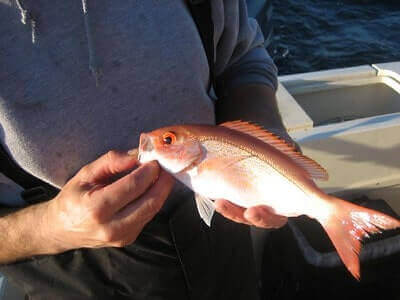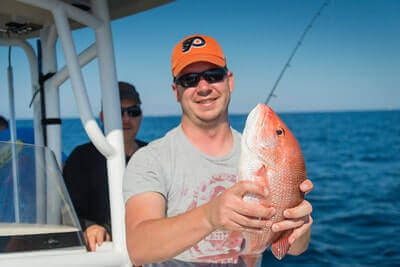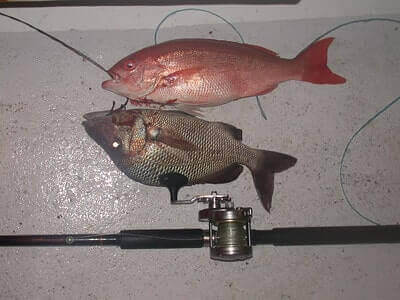Disclosure: We may earn commissions if you purchase products after clicking on a link from our site.
Are you interested in learning how to catch vermillion snapper? Vermillion snapper is not the sought-after snapper that anglers target. However, when anglers can’t find mangrove, red, or yellowtail snappers, vermillion snapper (beeliners) becomes a good alternative for fishing.
They can be found in the Atlantic Ocean from Cape Hatteras, North Carolina to southeastern Brazil, including the West Indies, the Gulf of Mexico, and the Caribbean Sea.
If you want to learn how to catch vermillion snapper, we will discuss the fishing methods, the baits and lures, fishing tackle, and tips to help you catch vermillion snapper.

Table of Contents
How To Catch Vermillion Snapper
Vermillion snapper is found over ledges, drop-offs, reefs, live bottom, rocks, sand bottom, and gravel. They are around those structures searching for baitfish. Although it is generally stated that vermillion snapper is a bottom fish, it isn’t really a bottom fish.
Bottom fishing is the fishing method anglers often use when fishing for beeliners. When using bottom fishing to catch beeliners, the key is to eventually get your bait midway in the water column where they are located. Use your fish finder or sonar device to locate the actual position of the vermillion snapper.
Then when you drop the bait, slowly release it until it reaches the beeliners where they are located in the water column. If the bait goes past them before they can strike it and it hits the bottom, slowly pull it up until it is located where they are.
1. Bottom Fishing
Bottom fishing is a popular method for targeting vermillion snapper, particularly around structures such as reefs, wrecks, and rock formations where these fish congregate. Anglers typically use a simple rig consisting of a sinker, leader, and hook baited with natural bait such as squid, cut fish, or shrimp. The rig is lowered to the bottom, and anglers maintain tension on the line while waiting for a strike.
Once a bite is detected, anglers should set the hook firmly to secure the catch. Bottom fishing can be done from boats or from shore, depending on the location of productive fishing grounds. Anglers should be aware of local regulations regarding the use of bottom fishing gear and practice responsible fishing techniques to minimize impact on vermillion snapper populations.
For more information on regulations and best practices for vermillion snapper fishing, anglers can refer to resources provided by government fisheries departments such as NOAA Fisheries.
2. Jigging
Jigging is an effective technique for catching vermillion snapper, particularly when they are holding over structure or suspended in deeper water. Anglers use specialized jigs designed to mimic the movement of baitfish or crustaceans, such as bucktail jigs, butterfly jigs, or vertical jigs.
The jig is dropped to the desired depth and then jerked or jigged up and down to entice strikes from vermillion snapper. Anglers can vary the speed and rhythm of their jigging motion to find what triggers the most bites. Jigging requires anglers to maintain sensitivity to detect subtle strikes, as vermillion snapper may hit the lure on the drop or during pauses in the retrieve.
It’s essential to use tackle appropriate for the size and strength of vermillion snapper, as these fish can put up a strong fight once hooked. Anglers should also be mindful of local regulations regarding the use of jigs and practice responsible fishing techniques to help conserve vermillion snapper populations.
3. Live Bait Fishing
Using live bait is another effective method for targeting vermillion snapper, particularly when other techniques may not be producing bites. Anglers can use a variety of live baits, including pilchards, pinfish, grunts, and small mullet, depending on local preferences and availability.
The live bait is hooked through the lips or back and then presented to vermillion snapper using a variety of rigs, such as a fish finder rig or Carolina rig. Anglers can fish live bait near the bottom or suspend it at various depths depending on where vermillion snappers are holding. Live bait fishing requires anglers to have a good understanding of the behavior and preferences of vermillion snapper, as well as the ability to keep live bait lively and attractive to feeding fish.
Anglers should also be mindful of local regulations regarding the use of live bait and practice responsible fishing techniques to help conserve vermillion snapper populations. For more information on regulations and best practices for vermillion snapper fishing, anglers can refer to resources provided by government fisheries departments such as NOAA Fisheries.
4. Trolling
Trolling can be an effective method for covering large areas of water and locating schools of vermillion snapper, particularly when they are dispersed over open flats or along the edges of reefs and drop-offs. Anglers use trolling rigs equipped with diving plugs, spoons, or small lures designed to attract vermillion snapper.
The rigs are trailed behind a moving boat at varying speeds, depending on the depth and desired presentation. Trolling allows anglers to cover a lot of ground quickly and can be particularly effective when targeting actively feeding fish or when searching for new fishing grounds. Anglers should be mindful of local regulations regarding the use of trolling gear and practice responsible fishing techniques to help conserve vermillion snapper populations.
5. Chumming
Chumming is a technique used to attract vermillion snapper to a specific area by dispersing a mixture of ground-up fish, fish parts, or other organic materials into the water. This method can be particularly effective when fishing over reefs, wrecks, or other structure where vermillion snapper are known to congregate.
Anglers can use a variety of chumming devices, such as mesh bags, buckets, or homemade chum dispensers, to release the chum into the water at a steady rate. Once vermillion snapper is attracted to the chum slick, anglers can present baits or lures to the feeding fish for a chance at a bite.
Chumming requires patience and persistence, as it may take some time for vermillion snapper to respond to the chum and begin feeding actively. Anglers should be mindful of local regulations.
Vermillion Snapper Fishing Tackle
A light tackle will work when fishing for beeliners. What is key is that the presentation must look natural to entice vermillion snapper to bite. Spinning tackle and a 10 lb test line can also be used when fishing for vermillion snapper.
Additionally, a half or three-quarter-ounce jig head tied to a 2 ft. long fluorocarbon leader attached to your line with a blood knot will get the job done. Vermillion snappers are attracted to chartreuse color, therefore use a chartreuse grub tail on the jig head and a small piece of bait.
Best Baits For Vermillion Snapper
- Squid
Squid is a highly effective bait for targeting vermillion snapper due to its scent, appearance, and durability. When properly presented, squid can entice vermillion snapper to bite in various fishing conditions. Anglers often use whole squid or squid strips as bait, threading them onto hooks in a way that mimics the natural movement of prey.
Squid can be fished both near the bottom and suspended in the water column, making it versatile for different fishing techniques such as bottom fishing, drift fishing, and vertical jigging. Additionally, squid remains intact on the hook despite the attention of smaller fish or strong currents, allowing anglers to keep their presentation attractive for longer periods.
This bait is readily available in most bait shops and can be stored frozen for extended periods, making it convenient for anglers. When targeting vermillion snapper with squid bait, anglers should experiment with different rigging techniques and presentation methods to determine what works best in their fishing location. Overall, squid remains a popular and reliable bait choice for anglers pursuing vermillion snapper.
2. Shrimp
Shrimp is a widely favored bait among anglers targeting vermillion snapper due to its natural appeal and widespread availability. These crustaceans emit an enticing scent and have a lifelike appearance that attracts vermillion snapper effectively.
Anglers often use fresh or frozen shrimp, which can be hooked whole or in sections depending on the size of the bait and the target fish. Shrimp can be presented in various ways, including on a bottom rig, Carolina rig, or jighead, depending on the fishing conditions and angler preferences.
Additionally, shrimp can be fished both near the bottom and higher up in the water column, making it versatile for different fishing techniques such as drift fishing and bottom fishing. When using shrimp as bait for vermillion snapper, anglers should ensure that the bait is securely hooked to prevent it from being easily stolen by smaller fish.
Furthermore, anglers may opt to add scent attractants or brine solutions to enhance the shrimp’s appeal to vermillion snapper. Overall, shrimp is a highly effective bait choice for anglers targeting vermillion snapper and is readily available in bait shops and seafood markets.
3. Crabs
Crabs are a natural and enticing bait choice for anglers targeting vermillion snapper. These fish are known to feed on a variety of crustaceans, including crabs, making them highly receptive to this bait. Anglers often use live or freshly dead crabs, such as blue crabs or fiddler crabs, to entice vermillion snapper.
The movement and scent of live crabs are particularly effective in attracting these fish, as they mimic the natural prey found in their habitat. Anglers typically rig the crab on a hook using the shell or body to secure it, allowing for natural movement in the water.
Additionally, cutting the crab into smaller pieces can release more scent and increase the chances of attracting vermillion snapper. When presenting crab bait, anglers may use various fishing techniques such as bottom fishing, drift fishing, or jigging, depending on the fishing conditions and preferences.
It’s essential to match the size of the hook and bait to the targeted vermillion snapper and adjust the rigging accordingly. Overall, crabs are a highly effective and versatile bait option for anglers pursuing vermillion snapper, offering a natural presentation that appeals to their predatory instincts.
4. Small fish
Small fish serve as excellent bait when targeting vermillion snapper due to their natural prey appeal. Species like pilchards, pinfish, and mullet are commonly used by anglers to attract these voracious feeders. The lively movement and natural scent of small fish make them irresistible to vermillion snapper, enticing them to strike.
Anglers often present small fish baits using various techniques such as bottom fishing, drifting, or jigging, depending on the fishing conditions and preferences. Rigging the baitfish on a hook to allow for natural movement in the water enhances its effectiveness. Some anglers prefer to use live baitfish, while others opt for freshly dead or cut bait to entice vermillion snapper. Adjusting the size of the hook and bait to match the targeted fish and employing proper rigging techniques are essential for successful fishing.

Best Lures For Vermillion Snapper
- Jigs
Jigs are versatile and effective lures for targeting vermillion snapper, offering anglers the flexibility to fish at various depths and locations. These artificial baits mimic the movement of small baitfish or crustaceans, which are the primary prey for vermillion snapper. Jigs come in a variety of shapes, sizes, and colors, allowing anglers to match the local forage and fishing conditions.
Common types of jigs for vermillion snapper fishing include bucktail jigs, vertical jigs, and butterfly jigs. Anglers can present jigs using different techniques such as jigging vertically near the bottom, casting and retrieving along the structure, or even trolling at slower speeds.
Adding a strip of cut bait or a soft plastic trailer to the jig can enhance its attractiveness and increase the chances of enticing a strike. It’s essential to experiment with jigging techniques, depths, and jig colors to determine what works best on any given day.
How To Catch Vermilion Snapper In The Gulf of Mexico
Fishing for vermillion snapper in the Gulf of Mexico involves bottom fishing. However, most of the time, the bait will not have to hit the bottom as vermillion snapper will not be located at the bottom. Vermillion snapper will often be found midway in the water column where they will be feeding on baitfish.
Locate their position with a fish finder and slowly drop your line to get to their position. Most of the time you will not need a heavy sinker as it will take the bait past the beeliners and go straight to the bottom.
Vermillion Snapper Fishing Tips
- Vermillion snapper can be found all year round offshore in the Gulf of Mexico.
2. Vermillion snappers often swim in large schools but don’t go very far.
3. You can find vermillion snapper over rocks, ledges, drop-offs, reefs, sand bottoms, and gravel.
4. They can be found in waters 60 to 400 feet deep, but are often found in waters less than 180 feet deep.

5. Although they are considered a bottom feeder, vermillion snapper is not really a bottom feeder.
6. Vermillion snappers are usually found midway in the water column where they feed. Many anglers have difficulty catching them because they are usually midway and not at the bottom.
7. Don’t use heavy sinkers that will take your bait past the beeliners and down to the bottom.
8. The key to successfully catching beeliners is locating where they are in the water column
and dropping your bait at that water level for them to bite.
9. When using the bottom fishing method to catch vermillion snapper, you must be a line watcher as it slowly sinks. The line will stop moving when a fish hits. Then reel up and set the hook.
10. Vermillion snappers are always on the move. Therefore, you must be patient when searching for them.
11. Chumming can also be used to bring vermillion snapper further up in the water column.

The Bottom Line
Vermillion snappers are usually found over ledges, drop-offs, reefs, live bottoms, rocks, sand bottoms, and gravel. They inhabit the waters in the Atlantic Ocean, from Cape Hatteras, North Carolina to southeastern Brazil, including the West Indies, the Gulf of Mexico, and the Caribbean Sea.
Vermillion snappers can be caught using bottom fishing although they are usually found midway in the water column. In this article, we discussed how to catch vermillion snapper, the often used fishing method to catch it, and tips to help you successfully catch them.
You can also read how to catch mutton snapper, how to catch mangrove snapper, how to catch lane snapper, how to catch red snapper, how to catch cubera snapper, and how to catch yellowtail snapper.